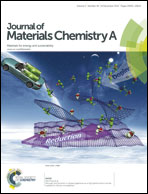Steric minimization towards high planarity and molecular weight for aggregation and photovoltaic studies†
Abstract
Taking into account the effect of planarity, alkyl chain steric hindrance and molecular weight towards high performance polymer solar cells, a “planar” semiconducting polymer PTOBDTDTffBT is designed. Minimal intra- and inter-molecular steric hindrances are realized by removing the alkyl chains at the 4,4′-positions of the DTffBT monomer and introducing shorter octyloxy chains on the BDT unit, respectively. Such a steric minimization strategy endows PTOBDTDTffBT with a high number average molecular weight of 343.37 kg mol−1, a planar conjugated backbone and strong inter-molecular aggregation characteristics as well. The optical properties indicate that the aggregation can only be partially broken even at 160 °C; theoretical calculations indicate that the polymer backbone has small distortion and the thiophene-phenyl bridge can move the octyloxy chains outward by 6.77 Å from the polymer backbone, both of which ensure the strong inter-chain aggregation. In spite of the high planarity and strong aggregation of the polymer, PTOBDTDTffBT is relatively amorphous in its film form, indicated by grazing incidence X-ray diffraction analysis. PTOBDTDTffBT exhibits a narrow bandgap of 1.71 eV together with a high ionization potential of 5.46 eV. Because of the strong aggregation of the polymer, the PTOBDTDTffBT/PC71BM active layer exhibits temperature-dependent photovoltaic performance. When the active layer is spin-coated at a relatively low temperature below 100 °C, PTOBDTDTffBT/PC71BM exhibits a stable power conversion efficiency above 6.6%. However, when the temperature is elevated from 120 °C to 160 °C, the power conversion efficiency decreased gradually to 3.58% because of the decreased short-circuit current density and fill factor. The temperature-dependent photovoltaic performance is explained by the fact that the PC71BM is easily spun out from the solution at higher temperatures as confirmed by the UV-vis absorption and X-ray photoelectron spectroscopy analysis. High temperatures can also lead to coarse morphology and large phase separation in the active layer observed from the atomic force microscopy and transmission electron microscopy images. Finally, a maximum power conversion efficiency of 7.68% is obtained when the active layer is spin-coated at 80 °C, which is a significant improvement of the power conversion efficiency for the “planar” PBDTDTffBT series.


 Please wait while we load your content...
Please wait while we load your content...